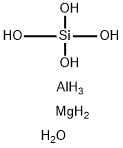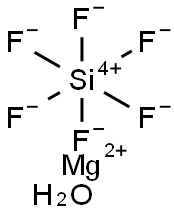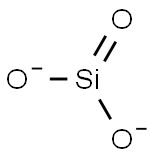Magnesium silicate
Synonym(s):Activated magnesium silicate;Florisil;Magnesium silicate;Magnesium Silicate Powder
- CAS NO.:1343-88-0
- Empirical Formula: MgO3Si
- Molecular Weight: 100.39
- MDL number: MFCD00078249
- EINECS: 215-681-1
- SAFETY DATA SHEET (SDS)
- Update Date: 2025-12-17 09:50:41

What is Magnesium silicate?
Absorption
Orally administered magnesium silicate is rapidly neutralized in the stomach and it forms magnesium chloride and silicon dioxide. From the modified portion, some of the formed magnesium is absorbed. The very low absorption of magnesium silicate makes its pharmacokinetic properties not relevant.
Toxicity
The administration of more than 50 meq of magnesium daily can produce the development of hypermagnesemia. This can provoke the formation of bladder and renal calculi. There is no known toxicity and the LD50 in animals are higher than 500 mg/kg in humans. It is determined that magnesium silicate is not carcinogenic.
Description
Magnesium silicate is very important in the earth sciences because it is the material that makes up most of the volume of the Earth. Magnesium silicate can be prepared by calcining the oxide with silica, SiO2, at an elevated temperature.
Chemical properties
white to off-white fine powder
Chemical properties
Magnesium silicate occurs as an odorless and tasteless, fine, whitecolored powder that is free from grittiness.
Chemical properties
A synthetic, usually amorphous form of magnesium silicate in which the molar ratio of silicon dioxide to magnesium oxide is approximately 2.2 to 3.3. It occurs as a very fine, white, odorless, tasteless powder, free from grittiness. It is insoluble in water and in alcohol, but is readily decomposed by mineral acids. The pH of a 1 in 10 slurry is between 7.0 and 10.8.
The Uses of Magnesium silicate
Magnesium Silicate is a white powder that is insoluble in water and functions as an anticaking agent. it is used in salt. it is also a process- ing aid and adsorbent which functions as an anticaking agent and remover of undesirable proteins during filtration. it is insoluble and a 10% slurry has a ph of approximately 7.0. it aids in the processing of beverages, food products, and pharmaceuticals by removing pro- tein/tannin complex constituents through surface area and adsorp- tive effects.
The Uses of Magnesium silicate
Florisil was used as column packing material in column chromatography. Florisil was used as an adsorbent in gas chromatography with electron capture detector (GC/ECD) , capillary column chromatography. and adsorption column chromatography. Florisil was used in clean-up procedures in gas chromatography-tandem mass spectrometry 4 and GC-FID.
The Uses of Magnesium silicate
A chromotographic adsorbant.
Background
Magnesium silicate is a compound of magnesium oxide and silicon. It is the magnesium salt of silicic acid containing an unspecified amount of water. The molecular formula can be expressed more clearly as MgSiO3.xH2O. It is known as talc and it presents many uses in the cosmetic industry, food industry and pharmaceutical industry. Under the FDA, magnesium silicate is determined as a member of the substances generally recognized as safe (GRAS) to be used as an anticaking agent.
Indications
Magnesium silicate is used to absorb moisture, prevent caking, and to improve the feel of a product. In the pharmaceutical companies, it is used as a dietary supplement, as part of the formulation ingredients in drug production, in antacid and antiulcer preparations, as a component of antiepileptic drugs, in antifungal topical agents and in the treatment of acne and as a facial moisturizer.
When complexed with arginine, magnesium silicate can be used as an antiatherosclerotic agent and to promote bone and cartilage formation in mammals.
What are the applications of Application
Magnesium silicate is a chromotographic adsorbant
Production Methods
Magnesium silicate may be prepared from sodium silicate and magnesium sulfate. The silicate also occurs in nature as the minerals meerschaum, parasepiolite, and sepiolite.
General Description
Florisil, adsorbent for the separation of lipids, is a commercially-prepared magnesia silica gel. It has a coarse mesh size which helps in rapid flow rate. Florisil is effective in promoting [1,3]-sigmatropic shift of myceophenolic acid related allyl phenyl ethers. Florisil cartridges are used in atmospheric sampling to assess possible interference from air contaminants.
Hazard
Toxic by inhalation, use in foods restricted to 2%.
Pharmaceutical Applications
Magnesium silicate is used in oral pharmaceutical formulations and food products as a glidant and an anticaking agent.
Safety
Magnesium silicate is used in oral pharmaceutical formulations and
is generally regarded as an essentially nontoxic and nonirritant
material.
Orally administered magnesium silicate is neutralized in the
stomach to form magnesium chloride and silicon dioxide; some
magnesium is absorbed. Caution should be used when greater than
50 mEq of magnesium is given daily to persons with impaired renal
function, owing to the risk of hypermagnesemia.
Reported adverse effects include the formation of bladder and
renal calculi following the regular use, for many years, of
magnesium silicate as an antacid.
Metabolism
The very low absorption of magnesium silicate makes its pharmacokinetic properties not relevant.
Properties of Magnesium silicate
| Melting point: | 1910°C |
| Density | 3.21 |
| storage temp. | Store at room temperature. |
| form | Powder |
| color | White to off-white |
| PH | 9.5 (100g/l, H2O, 20℃)(slurry) |
| Odor | at 100.00?%. odorless |
| Water Solubility | Insoluble in water. |
| CAS DataBase Reference | 1343-88-0(CAS DataBase Reference) |
| EPA Substance Registry System | Magnesium silicate (1343-88-0) |
Safety information for Magnesium silicate
| Signal word | Warning |
| Pictogram(s) |
 Exclamation Mark Irritant GHS07 |
| GHS Hazard Statements |
H315:Skin corrosion/irritation H319:Serious eye damage/eye irritation H335:Specific target organ toxicity, single exposure;Respiratory tract irritation |
| Precautionary Statement Codes |
P280:Wear protective gloves/protective clothing/eye protection/face protection. P302+P352:IF ON SKIN: wash with plenty of soap and water. |
Computed Descriptors for Magnesium silicate
| InChIKey | FKHIFSZMMVMEQY-UHFFFAOYSA-N |
Magnesium silicate manufacturer
JSK Chemicals
New Products
4,4-Difluoropiperidine hydrochloride tert-butyl 9-methoxy-3-azaspiro[5.5]undecane-3-carboxylate Indole Methyl Resin N-Isopropylurea N,N-Dicyclohexylcarbodiimide(DCC) MELDRUMS ACID 5-METHYLISOXAZOLE-4-CARBOXYLIC ACID Magnessium Bis glycinate Zinc ascorbate 1-bromo-2-butyne 2-acetamidophenol 9(10H)-anthracenone Erythrosin B, 4-Piperidinopiperidine 2-((4-morpholinophenylamino) (methylthio) methylene) malononitrile 2,4-dihydroxybenzaldehyde 3-(4-morpholinophenylamino)-5-amino-1H-pyrazole-4-carbonitrile Methyl 2-methylquinoline-6-carboxylate 2,6-dichloro-4-nitropyridine 4-Bromo-2-chlorobenzonitrile 2-(benzylamino)acetic acid hydrochloride 4-(tert-Butoxycarbonylamino)but- 2-ynoic acid 3,4-dihydro-2H-benzo[b][1,4]dioxepine 1-Phenyl-1-cycloprppanecarboxylicacidRelated products of tetrahydrofuran








You may like
-
 Magnesium silicate CAS 1343-88-0View Details
Magnesium silicate CAS 1343-88-0View Details
1343-88-0 -
 Magnesium silicate CAS 1343-88-0View Details
Magnesium silicate CAS 1343-88-0View Details
1343-88-0 -
 Florisil 60-100 mesh for chromatography CAS 1343-88-0View Details
Florisil 60-100 mesh for chromatography CAS 1343-88-0View Details
1343-88-0 -
 Fluorisil, 60-100 mesh CAS 1343-88-0View Details
Fluorisil, 60-100 mesh CAS 1343-88-0View Details
1343-88-0 -
 Fluorisil, 30-60 mesh CAS 1343-88-0View Details
Fluorisil, 30-60 mesh CAS 1343-88-0View Details
1343-88-0 -
 Florisil 60-100 mesh for column chromatography CAS 1343-88-0View Details
Florisil 60-100 mesh for column chromatography CAS 1343-88-0View Details
1343-88-0 -
 Florisil 70-230 mesh for column chromatography CAS 1343-88-0View Details
Florisil 70-230 mesh for column chromatography CAS 1343-88-0View Details
1343-88-0 -
 Florisil 230-400 mesh for column chromatography CAS 1343-88-0View Details
Florisil 230-400 mesh for column chromatography CAS 1343-88-0View Details
1343-88-0
